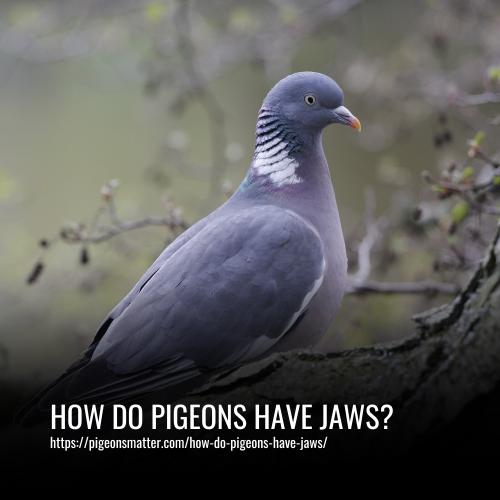Pigeons have a specialized oral structure adapted to their avian physiology. Their beak, also known as a bill, is comprised of upper and lower mandibles covered in a hard, keratinized sheath. Unlike the movable, hinged jaws of mammals, a pigeon’s beak is a solid, unarticulated structure. It lacks teeth altogether, relying on a different method of processing food.
Pigeons typically swallow seeds and grains whole, storing them temporarily in a specialized structure called the crop, where they are softened with the help of digestive enzymes before further processing in the stomach. While pigeons don’t have jaws in the traditional sense, their beaks are versatile and adapted to their diet, which primarily consists of seeds, grains, and small fruits.

Are jaws a bone?
Yes, jaws are indeed made of bone. In human anatomy, the jaw consists of two bones: the upper jaw, known as the maxilla, and the lower jaw, referred to as the mandible. These bones are hard, rigid structures primarily made of dense cortical bone tissue.
In mammals, including humans, jaws serve multiple essential functions. They house and protect the teeth, enabling biting, chewing, and grinding, which are crucial for the digestion of food. The jaw’s mobility, facilitated by joints, allows for the opening and closing of the mouth.
All animals, including mammals, have jaws composed of bone. In contrast to mammals, birds have beaks made of keratin, a proteinaceous material similar to human hair and nails, which are rigid, unarticulated structures that serve functions analogous to those of jaws but differ in composition.
How many jaw bones do Pigeons have?
Pigeons have two fused jaw bones, the maxilla and mandible, which are fixed to the skull and cannot move independently like the hinged jaws of mammals. Instead, Pigeons rely on their adaptable beaks, covered in a hard, keratinized sheath, to perform a wide range of functions such as capturing and manipulating food, grooming, building nests, and communicating.
The diverse shapes and sizes of Pigeon beaks are a result of evolution and are finely tuned to their specific dietary preferences and ecological niches. For example, Pigeons of prey have sharp, hooked beaks for tearing meat, while seed-eating Pigeons have beaks adapted for cracking seeds.
Overall, the rigid beak, rather than movable jaws with teeth, is the primary tool for various functions in a Pigeon’s life.
Do Pigeons Have Teeth?
No, pigeons do not have teeth. No bird species have teeth. Birds, including pigeons, are characterized by their toothless beaks, and this is a trait that has been present in birds since around 116 million years ago when teeth disappeared from their ancestors.
So, unlike humans, dogs, or even alligators, pigeons and all other bird species have evolved to rely solely on their beaks for eating and survival.
Therefore, if you ever find yourself wondering whether pigeons have teeth, the short and straightforward answer is no.
Does a pigeon have claws or nails?
Pigeons have claws, also known as talons, at the ends of their toes. These specialized structures are not the same as mammalian nails or human fingernails. Pigeons typically have three forward-pointing toes and one backward-pointing toe, each ending in a curved and sharp claw.
These claws are essential for perching, climbing, and maintaining balance while walking or landing. They provide pigeons with a firm grip on various surfaces, including tree branches, wires, and ledges.
The claws are also instrumental for tasks such as preventing falling or being blown away by strong winds, as well as for effective takeoff and landing. Overall, the claws of pigeons serve various functions essential for their survival and daily activities.
What Type Of Jaws Do Pigeons Have?
Pigeons have hooked narrow beaks, and beak-like jaws well-suited for eating seeds and small food items. The birds use their beaks to pick up food and also have a tongues to help with preening and keeping their beak clean.
Pigeons have two types of jaws: an upper jaw attached to the skull, and a lower jaw connected to the rest of the body via muscles and ligaments.
How Do Pigeons Use Their Jaws?
Pigeons use their jaws to eat, drink, and groom themselves. They also use their beaks to peck at objects and to preen their feathers. Pigeons have a lot of feathers, and they spend a lot of time preening them to keep them clean and in good condition.
Additionally, they use their beaks to break open seeds, eat small insects, and drink water. Overall, pigeons primarily use their jaws and beaks for eating, drinking, and grooming, as well as for ensuring the cleanliness and good condition of their feathers.
FAQs
Pigeons have a beak that is specially adapted for eating seeds. The upper jaw has a hard, curved ridge that the bird uses to crack the shell of the seed. The lower jaw has a softer, fleshy pad that the bird uses to rub the seed and remove the hull.
Yes, pigeons have jaws, but they’re not the same as mammalian jaws. Birds, including pigeons, have beaks made of keratin, a protein similar to our fingernails, which serves as their primary tool for feeding and manipulating food.
The beak of a pigeon is a specialized structure that combines the functions of jaws and a mouth. It’s a lightweight, durable structure that allows them to grasp, manipulate, and consume various types of food.
Unlike mammals, pigeons don’t have teeth. Instead, they have a unique adaptation called the “gizzard,” a muscular part of their digestive system that grinds food using small stones and pebbles they ingest, aiding in the digestion process.
Pigeons use their beaks to peck, grasp, and break apart food. Their beaks are versatile tools that enable them to pick up seeds, grains, and small objects. Pigeons don’t chew their food; instead, they swallow it whole or break it into smaller pieces before ingesting.
Yes, pigeons can open their beaks relatively wide. Their beaks are flexible enough to adjust according to the size and shape of the food they’re consuming, allowing them to pick up and handle various types of food items.
Pigeons’ beaks have a high density of sensory receptors, allowing them to sense touch and temperature, and even detect slight vibrations in their environment. This sensitivity aids in their feeding behavior, helping them locate and handle food efficiently.
Pigeons have a diet that consists mostly of seeds. Their beaks have a hard, horny covering that protects the delicate underlying tissue. The beak is curved to allow the pigeon to pluck seeds from the ground. The lower mandible is slightly longer than the upper mandible, which gives the beak a sharp, pointed tip. The pigeon’s jaws are adapted to their diet in that they can crack open the hard shells of seeds.
Conclusion
This article has provided valuable insights into the fascinating anatomy and evolution of pigeon jaws. Explaining how pigeons have jaws that are adapted for feeding on seeds, helps us understand the unique adaptations that have allowed pigeons and other birds to thrive in various environments.
Understanding the structure and function of pigeon jaws can also have practical applications in fields such as biology, zoology, and even robotics, as researchers can draw inspiration from nature to develop new technologies and designs.


